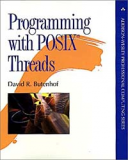
With this practical book, you will attain a solid understanding of threads and will discover how to put this powerful mode of programming to work in real-world applications.
The primary advantage of threaded programming is that it enables your applications to accomplish more than one task at the same time by using the number-crunching power of multiprocessor parallelism and by automatically exploiting I/O concurrency in your code, even on a single processor machine. The result: applications that are faster, more responsive to users, and often easier to maintain. Threaded programming is particularly well suited to network programming where it helps alleviate the bottleneck of slow network I/O.
This book offers an in-depth description of the IEEE operating system interface standard, POSIX (Portable Operating System Interface) threads, commonly called Pthreads. Written for experienced C programmers, but assuming no previous knowledge of threads, the book explains basic concepts such as asynchronous programming, the lifecycle of a thread, and synchronization. You then move to more advanced topics such as attributes objects, thread-specific data, and realtime scheduling. An entire chapter is devoted to "real code," with a look at barriers, read/write locks, the work queue manager, and how to utilize existing libraries. In addition, the book tackles one of the thorniest problems faced by thread programmers-debugging-with valuable suggestions on how to avoid code errors and performance problems from the outset.
Numerous annotated examples are used to illustrate real-world concepts. A Pthreads mini-reference and a look at future standardization are also included.
2.2.1 Creation
2.2.1 Creation
The "initial thread" of a process is created when the process is created. In a system that fully supports threaded programming, there's probably no way to execute any code without a thread. A thread is likely to be the only software context that includes the hardware state needed to execute code: registers, program counter, stack pointer, and so forth.
Additional threads are created by explicit calls. The primary way to create threads on a Pthreads system is to call pthread_create. Threads may also be created when the process receives a POSIX signal if the process signal notify mechanism is set to SIGEV_THREAD. Your system may provide additional nonstandard mechanisms to create a thread.
FIGURE 2.1 Thread state transitions
When a new thread is created, its state is ready. Depending on scheduling constraints, it may remain in that state for a substantial period of time before executing. Section 5.5 contains more information on thread scheduling. Going back to lifecycle.c, the thread running thread_routine becomes ready during main's call to pthread_create, at line 18.
The most important thing to remember about thread creation is that there is no synchronization between the creating thread's return from pthread_create and the scheduling of the new thread. That is, the thread may start before the creating thread returns. The thread may even run to completion and terminate before pthread_create returns. Refer to Section 8.1.1 for more information and warnings about what to expect when you create a thread.





